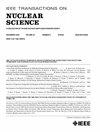Tritiated Perovskites: Experimental Insights for Tritium Betavoltaic Batteries
IF 1.9
3区 工程技术
Q3 ENGINEERING, ELECTRICAL & ELECTRONIC
引用次数: 0
Abstract
A new approach to developing an intrinsic betavoltaic battery is demonstrated by incorporating radiation-emitting isotopes, such as tritium, directly into the perovskite materials enabling direct power harvesting. The estimated power density for tritiated perovskite is 33.15 mW g-1 compared to 3.25 mW g-1 with conventional planar source-device structure. The long-term energy release is predicted at 73.8 kWh/kg of tritiated methylammonium lead triiodide (tritiated MAPbI3 or CT3NT3PbI3) over 12.32 years. A CT3NT3PbI3 crystal was synthesized using 4.44 mCi of tritiated water. Tritium incorporation into the final perovskite device was confirmed, with an uptake ratio of (氚包荧光体:氚型光伏电池的实验启示
通过将辐射发射同位素(如氚)直接加入钙钛矿材料中,从而实现直接能量收集,展示了一种开发本征贝塔伏打电池的新方法。氚化钙钛矿的估计功率密度为33.15 mW g-1,而传统平面源器件结构的功率密度为3.25 mW g-1。预测在12.32年内,氚化甲基三碘化铅(tritriated MAPbI3或CT3NT3PbI3)的长期能量释放为73.8 kWh/kg。用4.44 mCi的氚化水合成了CT3NT3PbI3晶体。证实了最终钙钛矿装置中氚的掺入,从氚化水到碘化甲基铵(MAI)前驱体的吸收率为(2.1~ 0.2)%。然而,制造的器件没有表现出整流行为,可能是由于未抛光的表面。I-V曲线也表现出明显的滞后性。提高氚吸收比的一个关键挑战是开发高浓度的氚化水。
本文章由计算机程序翻译,如有差异,请以英文原文为准。
求助全文
约1分钟内获得全文
求助全文
来源期刊

IEEE Transactions on Nuclear Science
工程技术-工程:电子与电气
CiteScore
3.70
自引率
27.80%
发文量
314
审稿时长
6.2 months
期刊介绍:
The IEEE Transactions on Nuclear Science is a publication of the IEEE Nuclear and Plasma Sciences Society. It is viewed as the primary source of technical information in many of the areas it covers. As judged by JCR impact factor, TNS consistently ranks in the top five journals in the category of Nuclear Science & Technology. It has one of the higher immediacy indices, indicating that the information it publishes is viewed as timely, and has a relatively long citation half-life, indicating that the published information also is viewed as valuable for a number of years.
The IEEE Transactions on Nuclear Science is published bimonthly. Its scope includes all aspects of the theory and application of nuclear science and engineering. It focuses on instrumentation for the detection and measurement of ionizing radiation; particle accelerators and their controls; nuclear medicine and its application; effects of radiation on materials, components, and systems; reactor instrumentation and controls; and measurement of radiation in space.
 求助内容:
求助内容: 应助结果提醒方式:
应助结果提醒方式:


